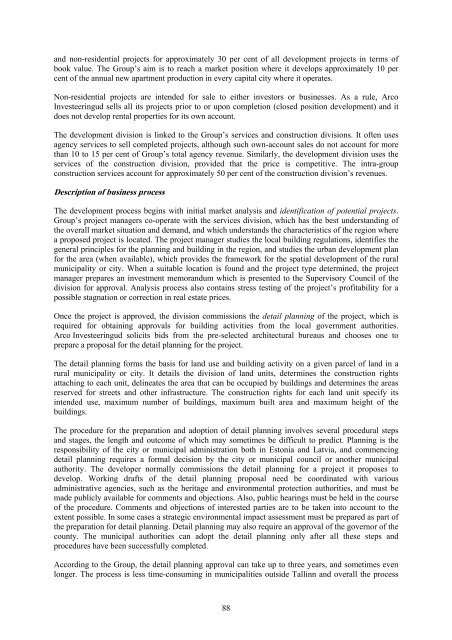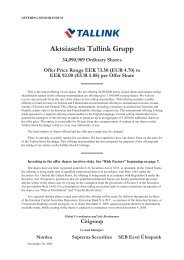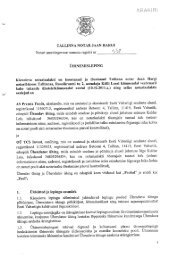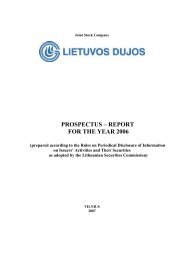ARCO VARA AS - NASDAQ OMX Baltic
ARCO VARA AS - NASDAQ OMX Baltic
ARCO VARA AS - NASDAQ OMX Baltic
You also want an ePaper? Increase the reach of your titles
YUMPU automatically turns print PDFs into web optimized ePapers that Google loves.
and non-residential projects for approximately 30 per cent of all development projects in terms of<br />
book value. The Group’s aim is to reach a market position where it develops approximately 10 per<br />
cent of the annual new apartment production in every capital city where it operates.<br />
Non-residential projects are intended for sale to either investors or businesses. As a rule, Arco<br />
Investeeringud sells all its projects prior to or upon completion (closed position development) and it<br />
does not develop rental properties for its own account.<br />
The development division is linked to the Group’s services and construction divisions. It often uses<br />
agency services to sell completed projects, although such own-account sales do not account for more<br />
than 10 to 15 per cent of Group’s total agency revenue. Similarly, the development division uses the<br />
services of the construction division, provided that the price is competitive. The intra-group<br />
construction services account for approximately 50 per cent of the construction division’s revenues.<br />
Description of business process<br />
The development process begins with initial market analysis and identification of potential projects.<br />
Group’s project managers co-operate with the services division, which has the best understanding of<br />
the overall market situation and demand, and which understands the characteristics of the region where<br />
a proposed project is located. The project manager studies the local building regulations, identifies the<br />
general principles for the planning and building in the region, and studies the urban development plan<br />
for the area (when available), which provides the framework for the spatial development of the rural<br />
municipality or city. When a suitable location is found and the project type determined, the project<br />
manager prepares an investment memorandum which is presented to the Supervisory Council of the<br />
division for approval. Analysis process also contains stress testing of the project’s profitability for a<br />
possible stagnation or correction in real estate prices.<br />
Once the project is approved, the division commissions the detail planning of the project, which is<br />
required for obtaining approvals for building activities from the local government authorities.<br />
Arco Investeeringud solicits bids from the pre-selected architectural bureaus and chooses one to<br />
prepare a proposal for the detail planning for the project.<br />
The detail planning forms the basis for land use and building activity on a given parcel of land in a<br />
rural municipality or city. It details the division of land units, determines the construction rights<br />
attaching to each unit, delineates the area that can be occupied by buildings and determines the areas<br />
reserved for streets and other infrastructure. The construction rights for each land unit specify its<br />
intended use, maximum number of buildings, maximum built area and maximum height of the<br />
buildings.<br />
The procedure for the preparation and adoption of detail planning involves several procedural steps<br />
and stages, the length and outcome of which may sometimes be difficult to predict. Planning is the<br />
responsibility of the city or municipal administration both in Estonia and Latvia, and commencing<br />
detail planning requires a formal decision by the city or municipal council or another municipal<br />
authority. The developer normally commissions the detail planning for a project it proposes to<br />
develop. Working drafts of the detail planning proposal need be coordinated with various<br />
administrative agencies, such as the heritage and environmental protection authorities, and must be<br />
made publicly available for comments and objections. Also, public hearings must be held in the course<br />
of the procedure. Comments and objections of interested parties are to be taken into account to the<br />
extent possible. In some cases a strategic environmental impact assessment must be prepared as part of<br />
the preparation for detail planning. Detail planning may also require an approval of the governor of the<br />
county. The municipal authorities can adopt the detail planning only after all these steps and<br />
procedures have been successfully completed.<br />
According to the Group, the detail planning approval can take up to three years, and sometimes even<br />
longer. The process is less time-consuming in municipalities outside Tallinn and overall the process<br />
88
















